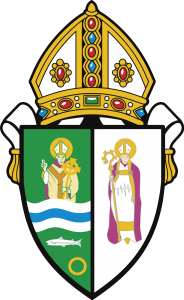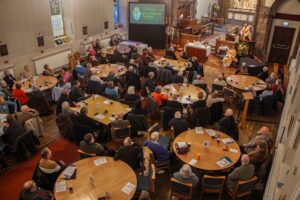A Brief History of the Diocese

The Diocese of Glasgow and Galloway is a union of two of the oldest dioceses in Scotland.
The Diocese covers the counties of Wigtonshire, Kirkcudbright and Dumfriesshire (the ancient Diocese of Galloway) and of Ayrshire, Lanarkshire, Renfrewshire, Dunbartonshire and West Stirlingshire south of the River Forth (the ancient Diocese of Glasgow).
The Diocese of Galloway, also known as ‘Candida Casa’ or Whithorn, meaning ‘White House’, was founded by St Ninian in the fifth century. The Diocese of Glasgow was founded in the sixth century by St Mungo, also known as St Kentigern, and patron saint of Glasgow.
St Mungo and St Ninian are respectively depicted on the left and right sides of the Diocesan shield.
On 9 January 1492, the Bishopric of Glasgow was raised in rank to be an Archbishopric. During the Scottish Reformation, the heritage and jurisdiction of the church passed into the hands of Church of Scotland. However, the small Scottish Episcopal Church continued the line of bishops of both dioceses, even though, in the 16th century, many of them held the office in title alone.
In 1697, the Diocese of Galloway was united with the Diocese of Edinburgh, and in 1708 the line of Archbishops of Glasgow fell vacant. At that point, episcopacy was abolished in the Church of Scotland and Episcopalians separated from the State church. The penal period in the 18th century, when the Episcopal Church was outlawed because of its adherence to the Stuart cause, was a low period for both Dioceses.
The line was revived with the appointment of Alexander Duncan in 1731 as Bishop, rather than Archbishop, of Glasgow. However, when Duncan died two years after his appointment as bishop, the see fell vacant once more. In 1787, William Abernethy Drummond became Bishop of Edinburgh and Galloway and Bishop of Brechin in a temporary personal union of the dioceses.
To this, he added the then vacant see of Glasgow in union with Edinburgh and Galloway. Within a year, Drummond gave way to John Strachan as the newly appointed Bishop of Brechin, and, in 1805, resigned from the united see of Edinburgh and Galloway (to Daniel Sandford) to focus on ministry in Glasgow. Drummond continued as Bishop of Glasgow until his death in 1809 when the see was reunited with Edinburgh and Galloway.
In 1837, James Walker, bishop of the triple see and Primus, gave way to Michael Russell to be the first modern Bishop of Glasgow and Galloway. In 1888, the counties of Selkirkshire, Peeblesshire and Roxburghshire, which were historically part of the Diocese of Galloway, were transferred from the Episcopalian Diocese of Glasgow and Galloway back to Edinburgh.
Bishops of Glasgow and Galloway
- 1837–1848: Michael Russell
- 1848–1859: Walter Trower
- 1859–1888; William Wilson
- 1888–1903: William Harrison
- 1904–1921: Ean Campbell
- 1921–1931: Edward Reid
- 1931–1938: Russell Darbyshire
- 1938–1952: John How (Primus 1946–1952)
- 1952–1974: Francis Moncreiff (Primus 1962–1973)
- 1974–1980: Frederick Goldie
- 1981–1991: Derek Rawcliffe
- 1991–1998: John Taylor
- 1998–2009: Idris Jones (Primus 2006–2009)
- 2010–2018: Gregor Duncan
- 2020–2024: Kevin Pearson
For more of the history of the Diocese, the Scottish Episcopal Church and the Church in Scotland, check our Resources.
Geography
The geographical area covered by the Diocese encompasses the city of Glasgow, the Greater Glasgow conurbation (Ayrshire, Lanarkshire, Dunbartonshire, Inverclyde and Renfrewshire,) as far as Helensburgh in the West (Argyll and Bute) and the whole of the Dumfries and Galloway region of South West Scotland (the former counties of Dumfriesshire, Kirkcudbrightshire and Wigtownshire).
The Diocese extends north from the Rhinns of Galloway and the Solway Firth through Ayrshire and the Firth of Clyde to its border with the Diocese of Argyll and the Isles, north of Helensburgh and Loch Lomond: a distance of 100 miles. The distance from Portpatrick, the westernmost southern congregation, across the Galloway region to Gretna on the English border, is again approximately 100 miles, as is the distance north from Gretna, up through Lanarkshire, east of Glasgow (bordering with the Diocese of Edinburgh east of Shotts) as far as the northern border with the Diocese of St Andrews, Dunkeld and Dunblane.
The City of Glasgow with the Glasgow conurbation is the most densely populated area of Scotland. However, many of the charges in the wider Glasgow ring have significant rural catchment areas and our congregations are mostly ‘gathered congregations’ (since, for historical and other reasons, there are many small towns without an Episcopal Church building). It is similarly important to note that while there are a number of churches in the city of Glasgow, there are no charges in the city centre. This lack of representation has been raised as a possible mission field for the future.
In the Galloway region, where Dumfries is the largest town and there is a predominantly scattered rural population, most of the congregations have a significant ‘small town’ and rural ministry. In some congregations, committed members have a round trip of 50 miles to attend public worship. The Galloway Region of the Diocese is the most widespread. Stranraer and Gretna are as near to Glasgow as they are to each other, and the east-west arterial route, the A75, is a single carriageway road for most of its traverse of the region.

